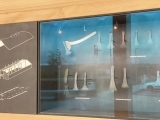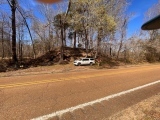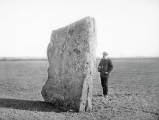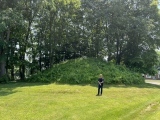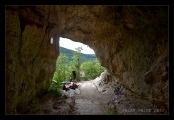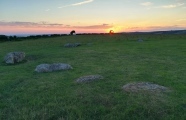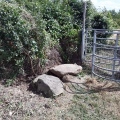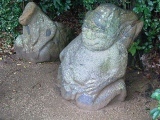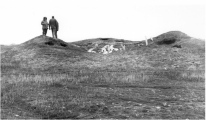Andy Burnham's Blog, page 97
August 6, 2023
St. Colmcille's Stone
A prehistoric tomb, most likely a wedge tomb, forming a low mound with a crown of orthostats all around. Believed to be the birthing stone of St. Columba. Legend has it that his mother, Elthne, gave birth to him upon this sacred stone.
Published on August 06, 2023 06:42
August 4, 2023
Rastanlage Leubinger Fürstenhügel
A display of the excavations of this royal tomb in the restaurant at highway 71 in Thuringia. You can also walk from the resting area towards the tomb of Leubingen over a footpath, or you can walk from the Tomb towards the Raststanlage. Very neatly done. The tomb is dated to the Bronze Age, the period of the Nebra Sky Disk. The burial mound was examined in 1877 and is attributed to the Únětice culture.
Published on August 04, 2023 04:05
Haynes Bluff Mounds
Haynes Bluff is one of Mississippi's most important sites due to the extended period of mound building that took place here. Native American people first started building the mounds during the Coles Creek Period, beginning around AD 850, and they continued to use them and to add to them well into the 18th century. Glass trade beads found in the upper portions of the mounds are an indication of the trade relations between Native American and European people in the early historic period. Photo courtesy Dr Greg Little and yes, that's the designated parking area.
Published on August 04, 2023 04:02
August 3, 2023
Devils Quoits
Top photo is from 1882 showing the largest stone and the photographer Henry Taunt. This was the only stone still standing before WW2, when it was buried. More archive photos on our page. Fully restored Stone Circle in Oxfordshire. The site is believed to be between 4000 and 5000 years old, and is a Scheduled Ancient Monument. The Quoits were restored between 2002 and 2008, with stones which had been knocked over or had fallen over being re-uprighted, and the surrouding earthworks re-built.
Published on August 03, 2023 05:25
Wolf Plains Group
The Wolf Plains Group is a Late Adena culture group of 30 earthworks including 22 conical mounds and nine circular enclosures. In 2008 The Archaeological Conservancy purchased the site of one of the remaining earthworks, the Dorr 2 Mound, using emergency funds; and it plans to purchase more as funds become available. The majority of the remaining earthworks in the complex are privately owned and are threatened with destruction as The Plains community expands. Photo courtesy Dr Greg Little, author of the Illustrated Encyclopedia of Native American Indian Mounds & Earthworks
Published on August 03, 2023 04:54
August 1, 2023
Kleine Scheuer
A cave used by humans in the Upper Paleolithic as various findings prove.
One of many caves inside the Rosenstein mountain.
One of many caves inside the Rosenstein mountain.
Published on August 01, 2023 07:47
July 31, 2023
Kingston Russell Circle
Midsummer sunset at Kingston Russell stone circle . The Kingston Russell stone circle is situated on the flat top of a chalk ridge, overlooking the Bride Valley to the north, and with views westwards to Abbotsbury Castle and the sea. The 18 stones are arranged in a near-circular formation, roughly 30 metres in diameter, and are of sarsen or conglomerate. It is assumed that the stones have fallen, or been moved, since recumbent circles are not usually found in this part of the country.
Published on July 31, 2023 03:12
July 30, 2023
Lower White Horse Stone
Rhpb thinks they may have found the remains of the lost Lower White Horse Stone - have a look at the photos on our page. The former location of a sarsen, destroyed circa 1823. It is presumed to have been a standing stone, but this is by no means certain, and consequently its identification as an archaeological monument rather than a natural feature is open to question. Suggestions that it might have represented remains of a chambered tomb are highly speculative. The name derives from a legend associating the stone with Hengist and Horsa
Published on July 30, 2023 06:57
July 29, 2023
Enigmatic sculptured stones around Asuka district, Nara pref., Japan
In the 7th century CE, Asuka-mura village was the capital of Japan. The area around it contains plenty of strange stone monuments most of which cannot be seen anywhere else, so out of scope of Buddhist statue researchers in Japan. The monuments might be roughly classified into following 6 categories (different opinions exist):
Published on July 29, 2023 07:35
July 28, 2023
Birnirk National Historic Landmark
Lots of mound photos incoming by kind permission of Dr Greg Little. Many thanks to AKFisher for the help in adding them. . A series of around 20 mounds on beach ridges on the Chukchi Sea coast near Utqiagvik (Barrow), Alaska. The mounds reach up to 14-feet tall and are dimpled with the sunken remains of house ruins and cache pits. They were formed by the construction of new houses on top of the ruins of older structures over hundreds of years.
Published on July 28, 2023 13:34


